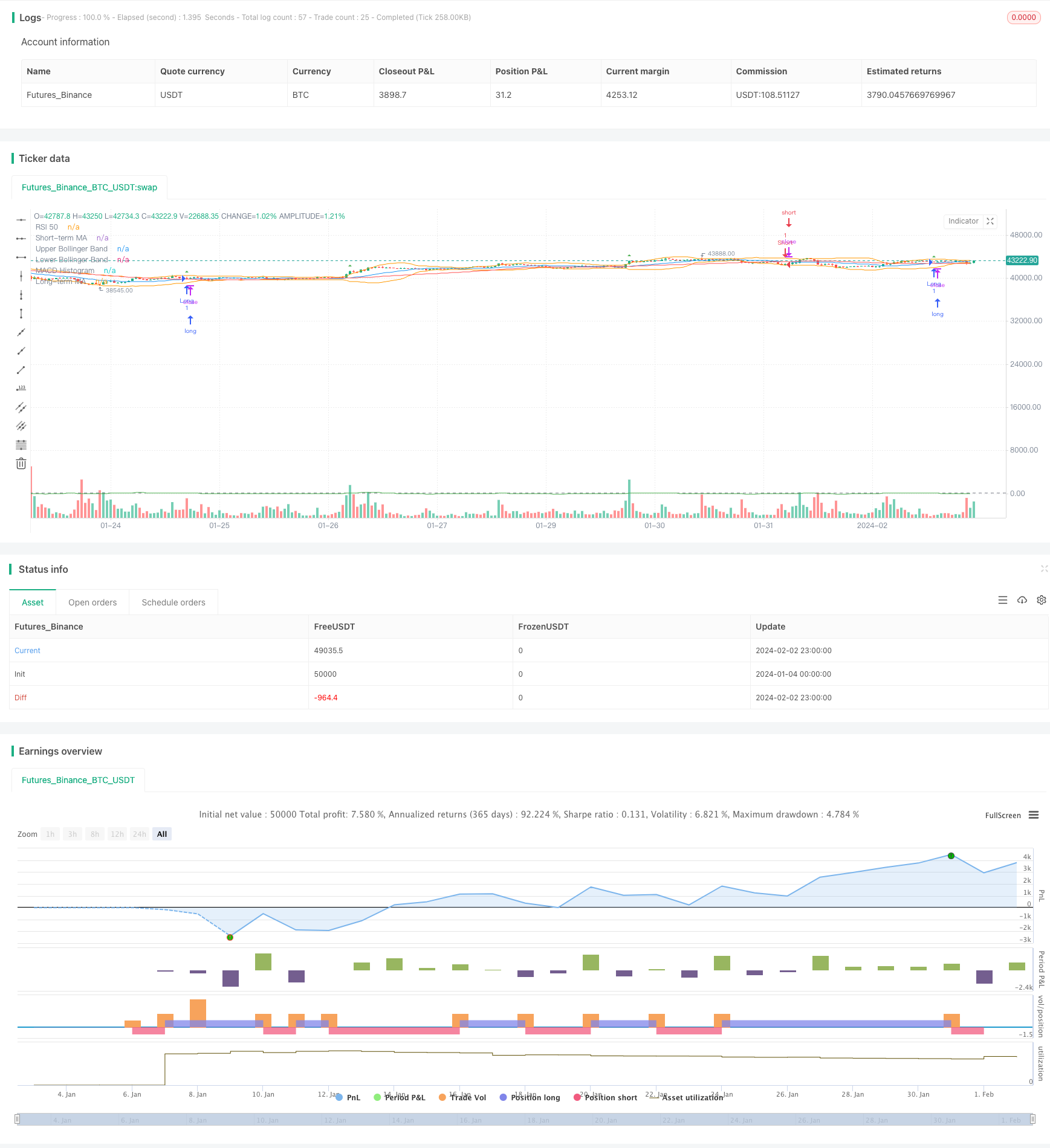Swing Trading Strategy Based on Momentum
Author: ChaoZhang, Date: 2024-02-04 10:59:36Tags:

Overview
The Swing Trading Strategy Based on Momentum, Oscillation and Moving Average Crossover is a strategy that uses momentum indicators, oscillators and moving average crossovers to generate buy and sell signals. It can be used for intraday and swing trading in commodities, forex and other markets.
Strategy Logic
The strategy utilizes four technical indicators - moving averages, Relative Strength Index (RSI), MACD and Bollinger Bands - to identify entry and exit signals. Specifically:
Go long when the short-term moving average crosses above the long-term moving average, and RSI is greater than 50; Go short when the short-term moving average crosses below the long-term moving average, and RSI is less than 50.
This combination takes advantage of golden crosses and death crosses of moving averages to determine the trend, while adding RSI to avoid the risk of trend reversal. MACD’s role is to determine specific entry points, and Bollinger Bands set the stop loss levels.
Advantage Analysis
The biggest advantage of this strategy is that the combination of indicators is appropriate to effectively utilize the complementary nature of trend and oscillation indicators. Specifically:
- Moving averages determine the main trend direction and trading signal points
- RSI helps avoid the risk of trend reversal
- MACD assists in determining specific entry points
- Bollinger Bands set stop loss levels
Through this combination, the advantages of each indicator can be fully utilized while complementing each other’s deficiencies.
Risk Analysis
The main risks of this strategy are:
- Trend reversal risk. When the market reverses rapidly, moving averages and RSI cannot give timely signals, which may lead to greater losses.
- False signals in range-bound markets. When the market oscillates for a long time, moving averages and RSI will frequently generate buy and sell signals, making it easy to be trapped.
- Inappropriate parameter settings. If the parameters are not set appropriately, the filtering effect will be poor and wrong signals are prone to occur.
To control these risks, methods like parameter optimization, setting stop loss/take profit, reasonably controlling position size can be adopted.
Optimization Directions
The strategy can be optimized in the following aspects:
- Test different market and time frame parameter combinations to find the optimal parameters.
- Add volatility indicators to better deal with oscillating markets.
- Add trading volume indicators to filter out false breakouts.
- Optimize parameters in real time with deep learning algorithms to make the system smarter.
- Optimize stop loss/take profit logic for better profitability and smaller losses.
Conclusion
The Swing Trading Strategy Based on Momentum, Oscillation and Moving Average Crossover identifies trading signals by utilizing the complementary advantages of trend and oscillator indicators. With proper parameter optimization and risk management, it can achieve good performance. The strategy can be further improved by optimizing parameters, stop loss logic etc. for even better results.
//@version=5
strategy("Swing Trading Strategy", overlay=true)
// Input for moving averages
shortMA = input(20, title="Short-term MA")
longMA = input(50, title="Long-term MA")
// Input for RSI
rsiLength = input(14, title="RSI Length")
// Input for MACD
macdShort = input(12, title="MACD Short")
macdLong = input(26, title="MACD Long")
macdSignal = input(9, title="MACD Signal")
// Input for Bollinger Bands
bbLength = input(20, title="Bollinger Bands Length")
bbMultiplier = input(2, title="Bollinger Bands Multiplier")
// Calculate moving averages
shortTermMA = ta.sma(close, shortMA)
longTermMA = ta.sma(close, longMA)
// Calculate RSI
rsiValue = ta.rsi(close, rsiLength)
// Calculate MACD
[macdLine, signalLine, _] = ta.macd(close, macdShort, macdLong, macdSignal)
// Calculate Bollinger Bands
basis = ta.sma(close, bbLength)
upperBand = basis + bbMultiplier * ta.stdev(close, bbLength)
lowerBand = basis - bbMultiplier * ta.stdev(close, bbLength)
// Plot moving averages
plot(shortTermMA, color=color.blue, title="Short-term MA")
plot(longTermMA, color=color.red, title="Long-term MA")
// Plot RSI
hline(50, "RSI 50", color=color.gray)
// Plot MACD
plot(macdLine - signalLine, color=color.green, title="MACD Histogram")
// Plot Bollinger Bands
plot(upperBand, color=color.orange, title="Upper Bollinger Band")
plot(lowerBand, color=color.orange, title="Lower Bollinger Band")
// Strategy conditions
longCondition = ta.crossover(shortTermMA, longTermMA) and rsiValue > 50
shortCondition = ta.crossunder(shortTermMA, longTermMA) and rsiValue < 50
// Execute trades
strategy.entry("Long", strategy.long, when=longCondition)
strategy.entry("Short", strategy.short, when=shortCondition)
// Plot trade signals on the chart
plotshape(series=longCondition, title="Long Signal", color=color.green, style=shape.triangleup, size=size.small)
plotshape(series=shortCondition, title="Short Signal", color=color.red, style=shape.triangledown, size=size.small)
- Bollinger Bands and RSI Combination Trading Strategy
- Demigod Candlestick MACD Divergence Trend Following Strategy
- Dual Moving Average Cross Timeframe Trading Strategy
- Dual Indicator Stochastic RSI and EMA Trading Strategy
- SMA Crossover Bullish Trend Following Strategy
- Bollinger Bands Breakout Quantitative Trading Strategy
- Trend Following Strategy Based on Multi-Period SMA
- Market Sentiment-Based Ichimoku Breakout Strategy
- Dynamic Multi-indicator Quantitative Trading Strategy
- Coral Trend Pullback Strategy
- Momentum Breakout Trading Strategy
- Trend Riding RSI Swing Capture Strategy
- Dual-Rail Parabolic SAR Bollinger Bands Strategy
- Triple Exponential Moving Average Profit Taking and Stop Loss Strategy
- Donchian Channel Width Trading Strategy
- Optimized Moving Average Crossover Strategy
- Isolation Band Oscillation Tracking Strategy
- Double Donchian Channel Breakout Strategy
- CRSI Moving Average Strategy
- Self-adaptive Quant Grid Trading Strategy